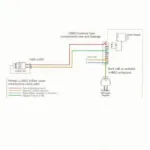The OBD2 code P0037 indicates a problem with the heater control circuit of the heated oxygen sensor (HO2S), specifically Bank 1, Sensor 2. This code can be a headache for car owners, but understanding what it means and how to address it can save you time and money. This article will dive deep into the P0037 code, its causes, symptoms, diagnostic procedures, and potential solutions.
Decoding the OBD2 P0037 Code
The P0037 code refers to a low voltage condition in the heater control circuit of the downstream oxygen sensor (sensor 2) on Bank 1. Bank 1 is the side of the engine that contains cylinder number 1. The downstream sensor is located after the catalytic converter and monitors its efficiency. The heated oxygen sensor plays a crucial role in maintaining optimal engine performance and fuel efficiency. Its heater allows it to reach operating temperature quickly, ensuring accurate readings for the engine control module (ECM).
A malfunctioning heater circuit can cause inaccurate readings, leading to increased emissions and reduced fuel economy. Understanding the intricacies of this code can empower you to take the necessary steps to resolve the issue.
What Causes the OBD2 P0037 Code?
Several factors can contribute to the P0037 code. These include:
- Faulty HO2S Heater: The heater element within the oxygen sensor itself may have failed.
- Wiring Issues: Damaged, corroded, or shorted wiring in the heater control circuit can cause voltage drops.
- Blown Fuse: A blown fuse in the HO2S heater circuit can interrupt power supply.
- Faulty ECM: In rare cases, a malfunctioning ECM can trigger the P0037 code.
Recognizing the Symptoms of P0037
While the check engine light illuminating is the most obvious symptom, other signs can indicate the P0037 code. These include:
- Decreased Fuel Economy: A noticeable drop in miles per gallon.
- Rough Idle: The engine may idle erratically.
- Failed Emissions Test: The vehicle may fail an emissions inspection due to increased emissions.
Diagnosing and Fixing the OBD2 P0037 Code
Diagnosing the P0037 code involves a systematic approach:
- Retrieve the Code: Use an OBD2 scanner to confirm the presence of the P0037 code. obd2 failed test can provide valuable insights.
- Visual Inspection: Inspect the wiring and connector of the Bank 1, Sensor 2 oxygen sensor for damage, corrosion, or loose connections.
- Voltage Test: Use a multimeter to check the voltage at the heater circuit connector.
- Resistance Test: Test the resistance of the HO2S heater element.
- Fuse Check: Verify that the fuse for the HO2S heater circuit is intact.
Based on the diagnosis, the appropriate repair can be made, which may include:
- Replacing the HO2S: If the sensor is faulty, replacement is necessary.
- Repairing Wiring: Damaged or corroded wiring should be repaired or replaced.
- Replacing the Fuse: A blown fuse should be replaced with the correct amperage rating.
- Addressing ECM Issues: If the ECM is faulty, it may require reprogramming or replacement.
mazda obd2 code p0037 offers specific guidance for Mazda vehicles.
Expert Insights on OBD2 P0037
“The P0037 code, while seemingly complex, often boils down to a simple wiring issue. Thorough inspection and testing are key to accurate diagnosis and effective repair.” – David Miller, Automotive Diagnostic Specialist
What is the typical cost to fix P0037?
The cost can vary depending on the specific repair needed. A new oxygen sensor typically costs between $50 and $250, while labor costs can range from $50 to $150.
“Addressing the P0037 code promptly is crucial. Ignoring it can lead to further damage to the catalytic converter, a significantly more expensive component.” – Sarah Johnson, Certified Mechanic
Conclusion
The OBD2 P0037 code signifies a problem within the heated oxygen sensor control circuit. By understanding the code, its causes, symptoms, and diagnostic procedures, you can effectively address the issue and restore your vehicle’s optimal performance and fuel efficiency. Don’t hesitate to seek professional help if needed. Remember, a properly functioning oxygen sensor is essential for a healthy engine and environment. obd2 torque appfor subaru review can be a helpful resource for Subaru owners. obd2 p0030 chevy provides information on a related code for Chevy vehicles.
FAQ
- Can I drive with a P0037 code? While driving short distances might be possible, it’s recommended to address the issue promptly to avoid further damage.
- How often should oxygen sensors be replaced? Oxygen sensors typically last between 60,000 and 90,000 miles.
- Will clearing the code fix the problem? Clearing the code will temporarily remove the check engine light, but the underlying issue will persist.
- Is the P0037 code the same for all car makes and models? Yes, the code definition is consistent across all OBD2 compliant vehicles.
- Can a bad fuel pump cause a P0037 code? While unlikely, a severely malfunctioning fuel pump can indirectly affect oxygen sensor readings.
- What other codes are related to P0037? Related codes include P0030, P0031, P0032, P0038, and P0039.
- Where can I find reliable information about OBD2 codes? Resources like OBDFree provide detailed information and troubleshooting guides for various OBD2 codes.
Need support? Contact us via WhatsApp: +1(641)206-8880, Email: [email protected], or visit us at 789 Elm Street, San Francisco, CA 94102, USA. Our customer support team is available 24/7.
